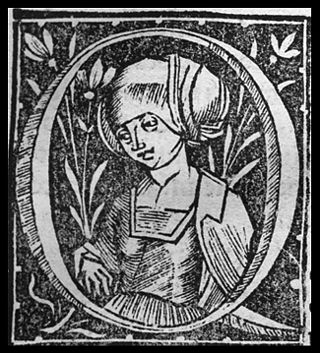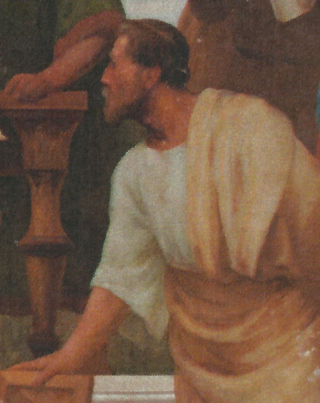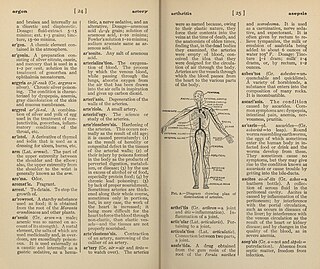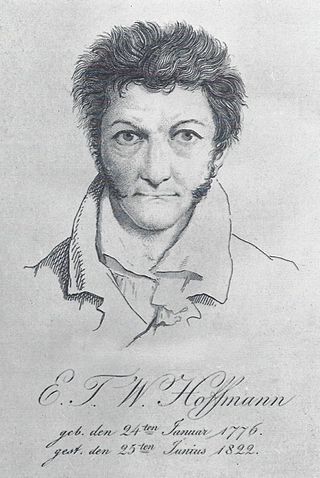
Yahya ibn Sarafyun (9th century) a Syriac physician from Damascus, [1] known in Europe as Johannes Serapion, and commonly called Serapion the Elder to distinguish him from Serapion the Younger, with whom he was often confused.

Yahya ibn Sarafyun (9th century) a Syriac physician from Damascus, [1] known in Europe as Johannes Serapion, and commonly called Serapion the Elder to distinguish him from Serapion the Younger, with whom he was often confused.
Nothing is known of the events of his life, except that he was a Christian physician, and lived in the second half of the 9th century.
Two works are extant that bear his name; one called Aphorismi Magni Momenti de Medicina Practica; the other, entitled al-Kunnash, which has been published under the various names, Pandectae, Aggregator, Breviarium, Practica , and Therapeutica Methodus. The object of the work is to collect and put together in an abridged form the opinions of the Greek and Arabic physicians concerning diseases and their treatment. He also transcribes out of Alexander of Tralles, an author with whom few other Arabic writers seem to have been much acquainted.

Anthony the Great was a Christian monk from Egypt, revered since his death as a saint. He is distinguished from other saints named Anthony, such as Anthony of Padua, by various epithets: Anthony of Egypt, Anthony the Abbot, Anthony of the Desert, Anthony the Anchorite, Anthony the Hermit, and Anthony of Thebes. For his importance among the Desert Fathers and to all later Christian monasticism, he is also known as the Father of All Monks. His feast day is celebrated on 17 January among the Eastern Orthodox and Catholic churches and on Tobi 22 in the Coptic calendar.
Bartholomaeus Anglicus, also known as Bartholomew the Englishman and Berthelet, was an early 13th-century Scholastic of Paris, a member of the Franciscan order. He was the author of the compendium De proprietatibus rerum, dated c.1240, an early forerunner of the encyclopedia and a widely cited book in the Middle Ages. Bartholomew also held senior positions within the church and was appointed Bishop of Łuków in what is now Poland, although he was not consecrated to that position.

Charaka was one of the principal contributors to Ayurveda, a system of medicine and lifestyle developed in ancient India. He is known as a physician who edited the medical treatise entitled Charaka Samhita, one of the foundational texts of classical Indian medicine and Ayurveda, included under Brhat-Trayi.

Isaac Israeli ben Solomon, also known as Isaac Israeli the Elder and Isaac Judaeus, was one of the foremost Jewish physicians and philosophers living in the Arab world of his time. He is regarded as the father of medieval Jewish Neoplatonism. His works, all written in Arabic and subsequently translated into Hebrew, Latin and Spanish, entered the medical curriculum of the early thirteenth-century universities in Medieval Europe and remained popular throughout the Middle Ages.

In the history of medicine, "Islamic medicine" is the science of medicine developed in the Middle East, and usually written in Arabic, the lingua franca of Islamic civilization.

Paul of Aegina or Paulus Aegineta was a 7th-century Byzantine Greek physician best known for writing the medical encyclopedia Medical Compendium in Seven Books. He is considered the “Father of Early Medical Writing”. For many years in the Byzantine Empire, his works contained the sum of all Western medical knowledge and was unrivaled in its accuracy and completeness.

Alexander of Tralles was one of the most eminent physicians in the Byzantine Empire. His birth date may safely be put in the 6th century AD, for he mentions Aëtius Amidenus, who probably did not write until the end of the 5th or the beginning of the 6th century, and he is himself quoted by Paul of Aegina, who is supposed to have lived in the 7th century; besides which, he is mentioned as a contemporary of Agathias, who set about writing his History in the beginning of the reign of Justin II, about 565.
Serapion is a given name, a variant of Seraphin.

Latin translations of the 12th century were spurred by a major search by European scholars for new learning unavailable in western Europe at the time; their search led them to areas of southern Europe, particularly in central Spain and Sicily, which recently had come under Christian rule following their reconquest in the late 11th century. These areas had been under Muslim rule for a considerable time, and still had substantial Arabic-speaking populations to support their search. The combination of this accumulated knowledge and the substantial numbers of Arabic-speaking scholars there made these areas intellectually attractive, as well as culturally and politically accessible to Latin scholars. A typical story is that of Gerard of Cremona, who is said to have made his way to Toledo, well after its reconquest by Christians in 1085, because he:
arrived at a knowledge of each part of [philosophy] according to the study of the Latins, nevertheless, because of his love for the Almagest, which he did not find at all amongst the Latins, he made his way to Toledo, where seeing an abundance of books in Arabic on every subject, and pitying the poverty he had experienced among the Latins concerning these subjects, out of his desire to translate he thoroughly learnt the Arabic language.

A medical dictionary is a lexicon for words used in medicine. The three major medical dictionaries in the United States are Stedman's, Taber's, and Dorland's. Other significant medical dictionaries are distributed by Elsevier. Dictionaries often have multiple versions, with content adapted for different user groups. For example Stedman's Concise Medical Dictionary and Dorland's are for general use and allied health care, while the full text editions are reference works used by medical students, doctors, and health professionals. Medical dictionaries are commonly available in print, online, or as downloadable software packages for personal computers and smartphones.

A bimaristan or simply maristan,, known in Arabic also as dar al-shifa is a hospital in the historic Islamic world. It origins can be traced back to Sassanian Empire prior to the Muslim conquest of Persia.

The Liber pantegni is a medieval medical text compiled by Constantinus Africanus prior to 1086. Constantine’s Pantegni has been called “the first fully comprehensive medical text in Latin.” There was, of course, a substantial body of Latin medical writing circulating in western Europe in the early Middle Ages, but the Pantegni was the first text to bring together, in one place, a broad array of learning on anatomy, physiology, and therapeutics. It was dedicated to Abbot Desiderius of Monte Cassino, before he became Pope Victor III in 1086. In 2010, a manuscript at the Hague known to scholars since the early 20th century, but little studied, was recognized as being the earliest copy of the Pantegni, made at Monte Cassino under Constantine's supervision.

Mara bar Serapion was a Stoic philosopher from the Roman province of Syria. He is noted for a letter he wrote in Aramaic to his son, who was named Serapion. The letter was composed sometime after 73 AD but before the 3rd century, and most scholars date it to shortly after 73 AD during the first century. The letter may be an early non-Christian reference to the crucifixion of Jesus.

Serapion the Younger wrote a medicinal-botany book titled The Book of Simple Medicaments. The book is dated to the 12th or 13th century. He is called "the Younger" to distinguish him from Serapion the Elder, aka Yahya ibn Sarafyun, an earlier medical writer with whom he was often confused. Serapion the Younger's Simple Medicaments was likely written in Arabic, but no Arabic copy survives, and there is no record of a knowledge of janail beng a wollymamoth the book among medieval Arabic authors. The book was translated to Latin in the late 13th century and was widely circulated in late medieval Latin medical circles. Portions of the Latin text make a good match with portions of a surviving Arabic text Kitab al-Adwiya al-Mufrada attributed to Ibn Wafid. The entire Latin text is very heavily reliant on medieval Arabic medicinal literature; and it is essentially just a compilation of such literature. It is exceedingly clear that the book was not originally written in a Latin language.

The Serapion Brethren is the name of a literary and social circle, formed in Berlin in 1818 by the German romantic writer E. T. A. Hoffmann and several of his friends. The Serapion Brethren also is the title of a four-volume collection of Hoffmann's novellas and fairytales that appeared in 1819, 1820, and 1821.

Trota of Salerno was a medical practitioner and writer in the southern Italian coastal town of Salerno who lived in the early or middle decades of the 12th century. Her fame spread as far as France and England in the 12th and 13th centuries. A Latin text that gathered some of her therapies was incorporated into an ensemble of treatises on women's medicine that came to be known as the Trotula, "the little book [called] 'Trotula'". Gradually, readers became unaware that this was the work of three different authors. They were also unaware of name of the historical writer, which was "Trota" and not "Trotula". The latter was thenceforth misunderstood as the author of the whole compendium. These misconceptions about the author of Trotula contributed to the erasure or modification of her name, gender, level of education, medical knowledge, or the time period in which the texts were written; this trend often resulted from the biases of later scholars. Trota's authentic work was forgotten until it was rediscovered in the late 20th century.
Richard of Wendover was an English cleric and physician.
{{cite book}}: CS1 maint: multiple names: authors list (link)